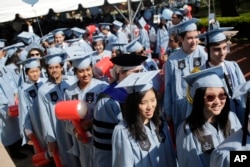LOS ANGELES — As California caps the number of international students at its public universities next year, educators worry about that action and a Trump administration proposed travel ban on some Muslim-majority countries sending the wrong signal to students overseas.
But so far, the United States remains the destination of choice for the world’s students, despite unwelcoming signals, say educators meeting in Los Angeles.
In May, the University of California decided to limit enrollment of out-of-state undergraduates to 18 percent at five of its 10 campuses to make more room for California students. Out-of-state students pay $27,000 more in added tuition and fees, and increase revenue for the university system.
The governing regents, who have authority over enrollment, placed a higher limit on UC campuses in Berkeley, Los Angeles, Irvine and San Diego because they already exceed 18 percent out-of-state enrollment. The regents pointed out that California campuses have higher international enrollment than the average for public universities nationwide.
California has the largest population of foreign students in the nation, hosting nearly 150,000 of more than 1 million international students in the U.S. University of California-Los Angeles has nearly 12,000 foreign students, the seventh-largest population among U.S. colleges.
The debate was intense, and one regent, Iranian-born Hadi Makarechian, said the proposal would build a wall around the university. The cap’s supporters say it expands opportunities for California residents.
International applications dropped at nearly 40 percent of American universities in March, after the first travel ban was proposed, according to a study released by several education associations. One, the Association of International Educators (NAFSA), held its annual meeting this week in Los Angeles.
Its educators say the California action should not start a trend.
“In fact, I think it mostly likely will be the opposite,” said John Wells of the College of Global Studies at Arcadia University in Pennsylvania. Arcadia sends its U.S. students abroad and accepts international students, mostly from China and India.
Wells says that as state funding for higher education “continues to become tighter and tighter ... many states are allowing their universities to find new means to recruit students, including an expanded focus on recruiting international students.”
Trump’s ban on visitors from six Muslim-majority countries has been temporarily blocked by federal courts. Amid the uncertainty, applications to many U.S. universities are down from the Middle East, according to the survey of U.S. universities.
Educators from other nations say their students have also been watching with concern, some preferring to apply to universities in Canada or Australia, said Iqbal Ahmed of the Acharya Institutes in Bangalore, India. “Still,” he said, “I think it’s not had a big impact” for students from India.
Many American universities actively recruit overseas, said Qimmah Najeeullah, director of international student and faculty services at Morgan State University in Baltimore, Maryland. She says her institution is combating what she calls a “widespread anti-immigrant sentiment in the United States” with a message to overseas applicants that “you’re part of the solution in coming ... and diversifying our student populace.”
Studying in America has expanded the worldview of a former student from India, Jayaditt Basani, who attended Chapman University in California. “You have people from so many different parts of the world already coming here,” he said, “so this is the best place to meet and make connections.”
Campus diversity helps American students, says Najeeullah of Morgan State University, allowing them to meet future overseas colleagues “that they can build businesses with, start companies with, help us to grow our footing in other markets.”
English-speaking countries, including Australia, Britain and Canada, attract significant international students, said John Wells of Arcadia University.
“Germany is actually increasingly strong as they expand the number of courses offered in English,” he said.
In the future, he speculates, China and the United Arab Emirates may be competitors.
But the United States remains the world’s top destination for international students, and Alzain Alhusein, a student advisor at Morgan State University, hopes it stays that way. Alhusein, who is now a U.S. citizen, came here as a student from Sudan, one of the countries on the Trump administration’s immigration ban.
He says the United States “is all about inclusion and diversity, and that’s the secret of America.”
These educators agree that public universities must serve Americans students, but say international students enrich their institutions. It’s a question, they say, of finding the right balance, and extending a welcome.
Please leave a comment here, and visit us on Facebook, Twitter, Instagram and LinkedIn, thanks!
But so far, the United States remains the destination of choice for the world’s students, despite unwelcoming signals, say educators meeting in Los Angeles.
In May, the University of California decided to limit enrollment of out-of-state undergraduates to 18 percent at five of its 10 campuses to make more room for California students. Out-of-state students pay $27,000 more in added tuition and fees, and increase revenue for the university system.
The governing regents, who have authority over enrollment, placed a higher limit on UC campuses in Berkeley, Los Angeles, Irvine and San Diego because they already exceed 18 percent out-of-state enrollment. The regents pointed out that California campuses have higher international enrollment than the average for public universities nationwide.
California has the largest population of foreign students in the nation, hosting nearly 150,000 of more than 1 million international students in the U.S. University of California-Los Angeles has nearly 12,000 foreign students, the seventh-largest population among U.S. colleges.
The debate was intense, and one regent, Iranian-born Hadi Makarechian, said the proposal would build a wall around the university. The cap’s supporters say it expands opportunities for California residents.
International applications dropped at nearly 40 percent of American universities in March, after the first travel ban was proposed, according to a study released by several education associations. One, the Association of International Educators (NAFSA), held its annual meeting this week in Los Angeles.
Its educators say the California action should not start a trend.
“In fact, I think it mostly likely will be the opposite,” said John Wells of the College of Global Studies at Arcadia University in Pennsylvania. Arcadia sends its U.S. students abroad and accepts international students, mostly from China and India.
Wells says that as state funding for higher education “continues to become tighter and tighter ... many states are allowing their universities to find new means to recruit students, including an expanded focus on recruiting international students.”
Trump’s ban on visitors from six Muslim-majority countries has been temporarily blocked by federal courts. Amid the uncertainty, applications to many U.S. universities are down from the Middle East, according to the survey of U.S. universities.
More than 100,000 people from that region studied in the United States in academic year 2015-2016, comprising 10 percent of the U.S. international students, according the Institute of International Education and its project Open Doors.
Educators from other nations say their students have also been watching with concern, some preferring to apply to universities in Canada or Australia, said Iqbal Ahmed of the Acharya Institutes in Bangalore, India. “Still,” he said, “I think it’s not had a big impact” for students from India.
Many American universities actively recruit overseas, said Qimmah Najeeullah, director of international student and faculty services at Morgan State University in Baltimore, Maryland. She says her institution is combating what she calls a “widespread anti-immigrant sentiment in the United States” with a message to overseas applicants that “you’re part of the solution in coming ... and diversifying our student populace.”
Studying in America has expanded the worldview of a former student from India, Jayaditt Basani, who attended Chapman University in California. “You have people from so many different parts of the world already coming here,” he said, “so this is the best place to meet and make connections.”
Campus diversity helps American students, says Najeeullah of Morgan State University, allowing them to meet future overseas colleagues “that they can build businesses with, start companies with, help us to grow our footing in other markets.”
English-speaking countries, including Australia, Britain and Canada, attract significant international students, said John Wells of Arcadia University.
“Germany is actually increasingly strong as they expand the number of courses offered in English,” he said.
In the future, he speculates, China and the United Arab Emirates may be competitors.
But the United States remains the world’s top destination for international students, and Alzain Alhusein, a student advisor at Morgan State University, hopes it stays that way. Alhusein, who is now a U.S. citizen, came here as a student from Sudan, one of the countries on the Trump administration’s immigration ban.
He says the United States “is all about inclusion and diversity, and that’s the secret of America.”
These educators agree that public universities must serve Americans students, but say international students enrich their institutions. It’s a question, they say, of finding the right balance, and extending a welcome.
Please leave a comment here, and visit us on Facebook, Twitter, Instagram and LinkedIn, thanks!





